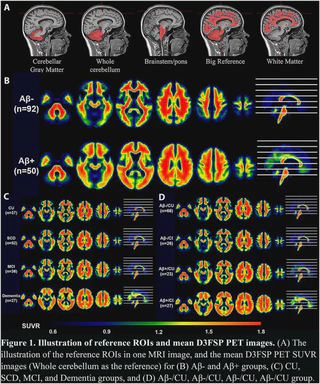[18F]-D3FSP amyloid-β PET imaging in elderly adults and Alzheimer’s disease
Dec 25, 2023·,,,,,,,, ,,,,,,,,,·
0 min read
,,,,,,,,,·
0 min read
Anqi Li
Ruiyue Zhao
Mingkai Zhang
Pan Sun
Yue Cai
Lin Liu
Guoyu Lan
Yalin Zhu
Xuhui Chen
Lizhi Guo
Yajing Zhou
Kun Sun
Lin Zhu
Hank F. Kung
Qingyong Wang
Linsen Xu
Ying Han
Xinlu Wang
Tengfei Guo

Abstract
N-methylderivative of Amyvid (18F-D3FSP) displayed very similar β-amyloid (Aβ) targeting properties to the 18F-florbetapir tracer, but it is not well established about the performance of 18F-D3FSP Aβ positron emission tomography (PET) imaging in Alzheimer’s disease (AD). In this study, we recruited 142 Greater-Bay-Area Healthy Aging Brain Study (GHABS) participants from the community and completed Simoa plasma biomarkers, MRI imaging, 18F-D3FSP Aβ PET imaging, and cognitive assessments. MRI images were segmented using FreeSurfer (v7.2.0) according to the Desikan–Killiany atlas. 18F-D3FSP Aβ PET images were coregistered with their corresponding MRI scans, and intensity-normalized to the mean uptakes in the whole cerebellum, cerebellar gray matter (cerebellar GM), brain stem (PONs), white matter, and big reference separately (Figure 1A). A cortical summary COMPOSITE 18F-D3FSP standardized uptake value ratio (SUVR) in AD typical cortical regions was calculated. We used Gaussian Mixture Model to estimate 2 gaussian distributions of low and high Aβ for COMPOSITE SUVRs, and the threshold was defined as an SUVR corresponding to a 90% probability of belonging to the low-Aβ distribution. COMPOSITE SUVRs were compared between Aβ- and Aβ+ groups. Finally, we investigated the association of COMPOSITE SUVR with plasma biomarkers, including age and sex as covariates. 18F-D3FSP Aβ PET imaging was capable of detecting fibrillary Aβ plaques in AD, and the Aβ+ group showed substantial Aβ deposition compared to the Aβ- group (Fig.1B). The dementia patients had more Aβ burden than the CU, SCD, and MCI individuals (Fig.1C), and the preclinical AD individuals (Aβ+/CU) showed significantly higher Aβ SUVRs than the Aβ-/CI and Aβ-/CU groups (Fig.1D). The comparisons of COMPOSITE SUVR between Aβ- and Aβ+ had a very high effect size, particularly in the brain stem reference region (Fig.2). Higher COMPOSITE SUVRs were related to lower plasma Aβ42/40 and higher plasma p-Tau, GFAP, NfL concentrations, especially based on the composite big reference region (Fig.3). [18F]D3FSP is an effective Aβ tracer to detect Aβ deposition in AD. Using the big reference may be optimal for calculating SUVR by considering the Aβ positive effect size and its correlation with Aβ, tau, neurodegeneration, and neuroinflammation measured in plasma.
Type
Publication
Alzheimer’s & Dementia